Italy’s Cinque Terre is the stuff of postcards, and its colourful coastal railway is as pretty as a picture. Tristan Rutherford takes a train journey of discovery along the Ligurian coast
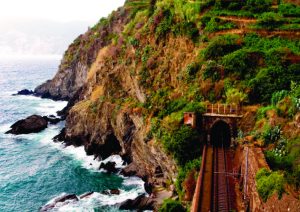
Central Italy is snowbound, so it is a shock to see La Spezia Station in radiant green. Palm trees run alongside the tracks in this remote outpost of Liguria, while window boxes dot the station building and Piaggio three-wheelers fill the car park. Sixty miles down the coast from the province’s capital of Genoa, La Spezia is cut off from the poplars, fog and fancy cars of neighbouring Tuscany by a long train tunnel.
Market day entices elderly shoppers, who mob the midday train for the Cinque Terre discussing their morning bargains. Not for nothing are Ligurians known as the tightwads of Italy. But they are sprightly and in good spirits; before this lifeline rail route to the remote but dramatically sited villages of Riomaggiore, Manarola, Corniglia, Vernazza and Monterosso started in the 1950s, their vegetables were grown by hand on the hills, then hauled over the six-mile stretch of precipitous cliffs that separate the villages from La Spezia.
Back then, the communities were almost as isolated from one another as they were from the outside world. The literal translation of Cinque Terre is significant: not five villages, but five lands.
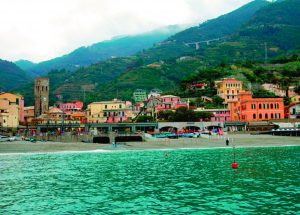
The line from La Spezia to Genoa follows a two-hour coastal curve northwest, but all onboard are heading to the most southerly Cinque Terre village of Riomaggiore, just ten minutes but a whole world away. Shopping bags, winter gloves and the odd pair of designer shades are lost in darkness as the carriages bore straight through the limestone cliffs. The ceiling’s 1980s fluorescent tube lighting fails to kick in, but that’s hardly surprising, since it looks like little has been touched in the three decades since this train hit the tracks.
Eyes adjust to the five-minute blackout. The elderly passengers brace themselves: when the bright light returns, one feels a pop of the ears. A five-second exposure to the scenery, featuring a horizon-filled snapshot of grey ocean-rollers hammering the towering green cliffs, is all that’s allowed before the train burrows back inside again; the vista is similar five minutes further down the line at Riomaggiore Station, which is constructed majestically over the tempestuous Mediterranean.
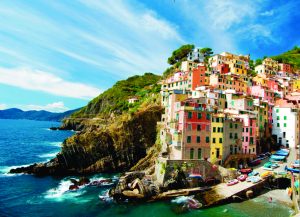
On the platform, the local passengers join a trio of young Americans clad in hiking gear. Sensible shoes and sturdy jackets give way to the rainbow colours of Lowe Alpine and North Face; walking between villages, instead of using the rails, is now back in vogue. For six months a year, this trickle of hikers becomes a torrent, thanks mainly to the enthusiasm of one travel journalist. Rick Steves’ Europe through the Back Door lifted the lid on untouched Italy in 1980. Cinque Terre remains the easily accessible ‘seaside’ bit on Steves’ suggested 22-day itinerary, just two hours from Genoa or an hour from Pisa – a Grand Tour squished into a spring break. But the sight is still inspiring three decades later: five picture-perfect villages unblighted by modern times, their pastel-coloured hotchpotch of buildings now protected by a UNESCO World Heritage order. The area’s former seclusion kept the villages unspoilt, while their current convenience keeps them rich.
Winter in Cinque Terre looks like a six-month sabbatical for some. It’s still warm enough to join the café-dwelling Riomaggiore locals alfresco overlooking the flower-filled main street. A convivial scene, but times look a whole lot tougher in one of the establishment’s black-and-white photos, taken in the distant days before the station and harbour wall were built: in the picture, huge waves smash through the village streets where the café terrace now stands.
Riomaggiore’s local history museum sums up the hardship in the days before the train. At the time of Italy’s creation in 1860, coins from the new Republic’s mint were worthless in these lonely climes. Imports such as clogs – though some locals simply went barefoot – were swapped with exports of oil and fruit. Particularly prized was the hard-wearing blue work cloth from Genoa, or Gênes as the port is known in French (repeat the name while thinking of blue denim trousers).
By the 1880s, emigration was rife, indeed half of all Italians leaving for the United States at this time were from Liguria, escaping with their jeans from grinding poverty. The situation was exacerbated by the fact that Genoese traders paid local peasant farmers a pittance for their main export, wine. Back in those days, long before the coastal trains, locals were regarded as naive. And yet, even then, the local vintage had earned a formidable reputation among oenophiles. The humanist Giacomo Braceli, visiting in 1448, raved about scenery and the wine: ‘It is an authentic delight to observe mountains, not merely steep, but precipitous to the point that even birds have difficulty flying over them. Covered by vines so thirsty and more similar to ivy… here wine is made that adorns the tables of kings.’ Indeed, thanks to Cinque Terre’s contemporary contact with the outside world, its wine now boasts DOC status, bringing new prosperity to the local grape-growers.
A vine romance
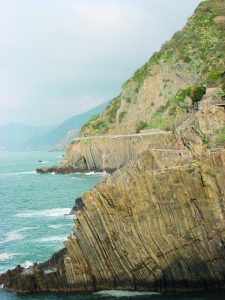
Lofty vineyards mark the coastal path from Riomaggiore station to the platform at Manarola, forming the easiest and most popular of the five village-to-village walks. Long gone are the days of lugging bunches of grapes down the terraces to waiting gozzi, or fishing boats, for transport to a cantina along the coast. Now there is a rail contraption – a flexible mini-monorail on stilts, hundreds of which stripe the terraces. Easy to lay and to operate, these inexpensive inventions can whizz bunches of grapes down the terraces, and whizz packed lunches back up them.
This part of the trip is best done on foot, as the train returns inside the limestone cliff, missing out the heady scents along the trail. The musky potpourri is spiced with olive, wild rucola, wood smoke, pine and figs (once planted to give the grape-pickers some shade). Birdsong is everywhere – and no wonder. The Cinque Terre region set itself up as a National Park in 1999, with a philsophy that espoused environmentally friendly and organic practices – newfangled terms for what has been a longstanding way of life here. Cinque Terre missed out on the plastic fantastic fad the first time round, becoming a pioneer in the eco-tourism and recycling game without even realising it.
The coastal path certainly lives up to its pretty name, the Via dell’Amore. Just before Manarola, the path narrows into a lovers’ alley, a graffitied walkway bearing the passionate scribbles from the world over – ‘Hilde? Ordin’, ‘Sasha + Brent’, ‘Beppe e Silvia 03’ – plus the infrequent yet touching misspelling: ‘Sammy I lover you’.

Waiting to board the next train at Manarola station is a family of four New Zealanders. Their nationality (and address) is confirmed by their luggage tags. With Gore-Tex jackets and zipaway outdoor trousers, they came prepared for the elements. Sun is still shining on the snowy mountains on the other side of the gulf of Genoa, as one of them takes out a camera with automatic zoom. ‘I’m trying to focus in on the Pyrenees.’ None of the other English-speaking passengers has the heart to correct them.
Fairytales can come true
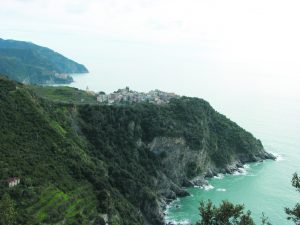
A Spanish foursome have also got their holiday heads on as they loiter on the edge of the platform on the other side. From nowhere, a locomotive muscles out of the tunnel like a raging bull, its 50 containers a breakneck blur of Maersk and P&O, and the jumpy Spaniards look miffed by this 1,000-tonne close shave, perhaps forgetting that they’re standing next to Italy’s west coast mainline between Genoa and Rome.
For the run past the three remaining villages, keep your eyes glued to the window. The ten minutes of curving track from the fairytale redoubt of Corniglia to the bobbing boats of Monterosso is a provençal palette of burnt orange, lemon grove green and summer sky blue. The teetering buildings of the middle village, Vernazza, stand proud and vivid on a jut of land,
like majestic lighthouses built on arches of rock.
Ten minutes further on, at the pre-1950s railhead of Sestri Levante, many of the passengers jump on the return train to La Spezia to repeat the harmonious kaleidoscope once again. The Spanish and New Zealanders from Manarola are changing here too; take a day trip along 30 minutes of scenic train track and you are destined to see the same people twice.
Years ago, the La Spezia-to-Sestri Levante leg took five hours in a less regular, but pioneering train. In post-war Italy, where roads were few and far between, people actually drove their cars on to Channel Tunnel-type carriages. The train hauled these drive-on, drive-off wagons over the hilltops, instead of through the tunnels, on this now-defunct route.
The onward service from Sestri Levante to Genoa is equally dated, but by no means obsolete. Carriages are split into ten six-person compartments with reclining armchair seats; these are the comfortable workhorses of cross county Italian rail travel. The stainless steel heater at ground level keeps the cabin cosy as flurries of snow cover the track. A touch-sensitive PC screen lies in a fellow passenger’s hand. ‘Is he a photographer?’ ‘Yes.’ ‘Has he taken photos for anyone famous?’ ‘Elle Decor, World of Interiors, Vogue, people like this.’ He’s returning from the glitzy resort of Pietrasanta, near Pisa, where he photographed a millionaire’s villa.
Sunset finally arrives over the equally classy resort of Santa Margherita, sister town of glamorous Portofino, just across the bay. Liberty-style mansions, castle-cum-hotels and a regimentally precise straight line
of palms make up the scene, a legacy of the Roaring Twenties, when the easily reached Italian Riviera was an extension of the French. The photographer tries to point out the villa of fashion designers Dolce and Gabbana in the next bay; the contrast with homely, pastel-hued Cinque Terre is total.
A final shunt into Genoa comes in the darkness of early evening. Back in Riomaggiore, the newly prosperous inhabitants will be uncorking their newly designated DOC wine right about now.
